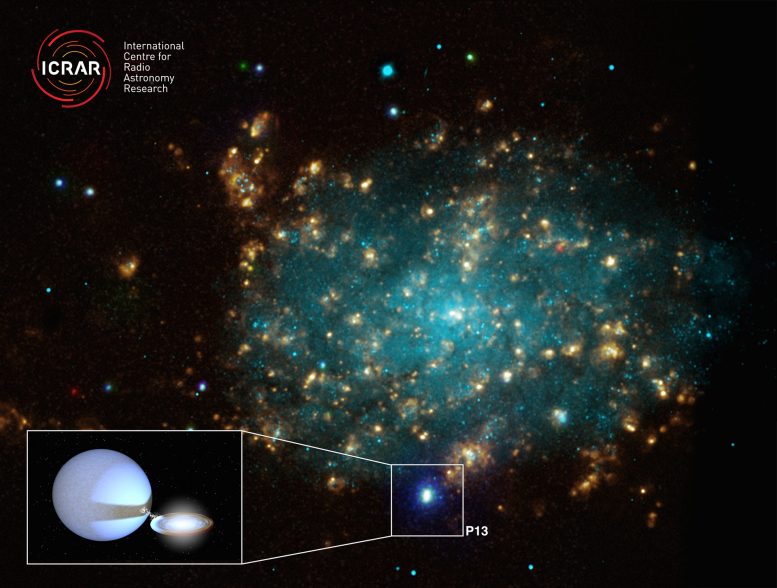
Primary Image: A combined optical/X-ray image of NGC 7793 Credit: X-ray (NASA/CXC/Univ of Strasbourg/M. Pakull et al); Optical (ESO/VLT/Univ of Strasbourg/M. Pakull et al); H-alpha (NOAO/AURA/NSF/CTIO 1.5m)
Inset image: A rendering of what P13 would look like close up. Credit: created by Tom Russell (ICRAR) using software created by Rob Hynes (Louisiana State University).
In a new study, a team of astronomers reveals that the black hole known as P13 is consuming gas from a nearby star 10 times faster than previously thought possible.
Astronomers have discovered a black hole that is consuming gas from a nearby star 10 times faster than previously thought possible. The black hole—known as P13—lies on the outskirts of the galaxy NGC7793 about 12 million light-years from Earth and is ingesting a weight equivalent to 100 billion billion hot dogs every minute.
The discovery was published today in the journal Nature.
International Center for Radio Astronomy Research astronomer Dr Roberto Soria, who is based at ICRAR’s Curtin University node, said that as gas falls towards a black hole it gets very hot and bright. He said scientists first noticed P13 because it was a lot more luminous than other black holes, but it was initially assumed that it was simply bigger.
“It was generally believed the maximum speed at which a black hole could swallow gas and produce light was tightly determined by its size,” Dr Soria said.
“So it made sense to assume that P13 was bigger than the ordinary, less bright black holes we see in our own galaxy, the Milky Way.”
When Dr Soria and his colleagues from the University of Strasbourg measured the mass of P13 they found it was actually on the small side, despite being at least a million times brighter than the Sun. It was only then that they realized just how much material it was consuming.
“There’s not really a strict limit like we thought, black holes can actually consume more gas and produce more light,” Dr. Soria said. Dr. Soria said P13 rotates around a supergiant ‘donor’ star 20 times heavier than our own Sun.
He said the scientists saw that one side of the donor star was always brighter than the other because it was illuminated by X-rays coming from near the black hole, so the star appeared brighter or fainter as it went around P13.
“This allowed us to measure the time it takes for the black hole and the donor star to rotate around each other, which is 64 days, and to model the velocity of the two objects and the shape of the orbit,” Dr Soria said.
“From this, we worked out that the black hole must be less than 15 times the mass of our Sun.”
Dr. Soria compared P13 to small Japanese eating champion Takeru Kobayashi.
“As hotdog-eating legend Takeru Kobayashi famously showed us, size does not always matter in the world of competitive eating and even small black holes can sometimes eat gas at an exceptional rate,” he said.
Dr. Soria said P13 is a member of a select group of black holes known as ultraluminous X-ray sources.
“These are the champions of competitive gas eating in the Universe, capable of swallowing their donor star in less than a million years, which is a very short time on cosmic scales,” he said.
Reference: “A mass of less than 15 solar masses for the black hole in an ultraluminous X-ray source” by C. Motch, M. W. Pakull, R. Soria, F. Grisé and G. Pietrzyński, 8 October 2014, Nature.
DOI: 10.1038/nature13730









It seems that the conclusions to be drawn from these observations are that:
1. The brightness of an object such as P13 depends more on the availability of gas to be sucked in than the size of the black hole, and
2. P13 can be expected to increase in brightness as its mass – and the rate of gas intake – increases, until the donor star has reached “peak gas delivery”, after which the brightness will reduce until the donor star has no more to give. Alternatively, the donor star may go supernova when the pressure of its gas coat is inadequate to “bottle up” the dynamic balance of nuclear fission and fusion reactions of the heavy elements in its core.